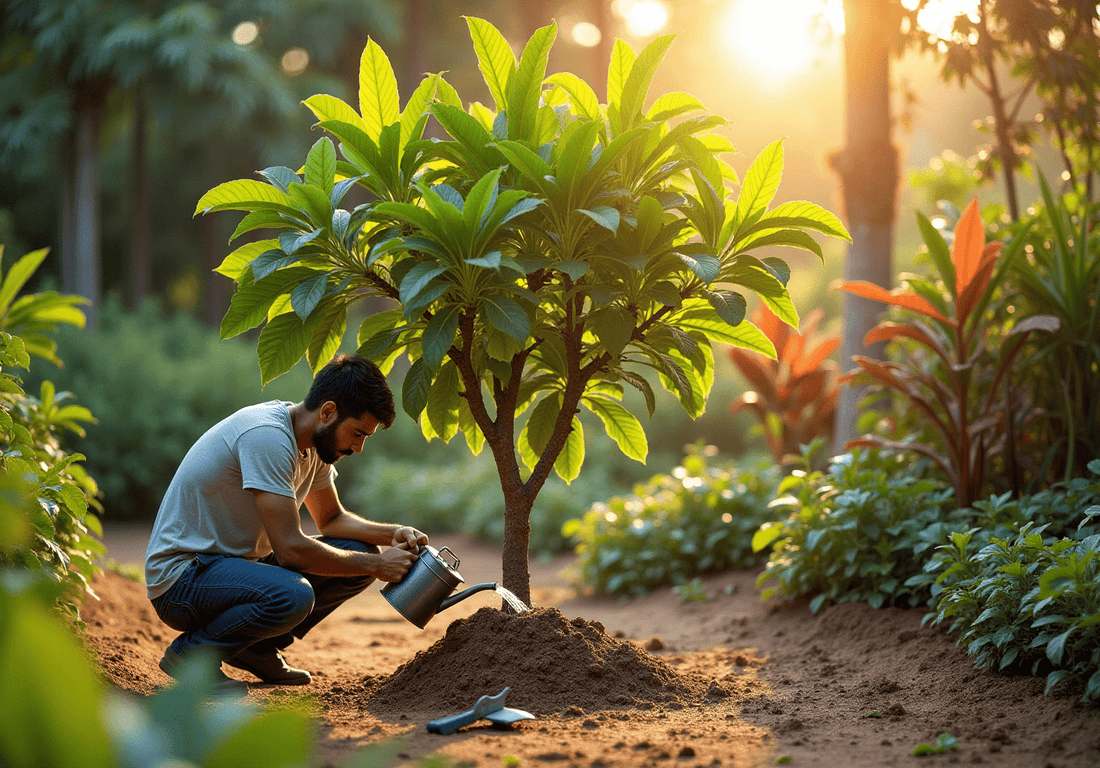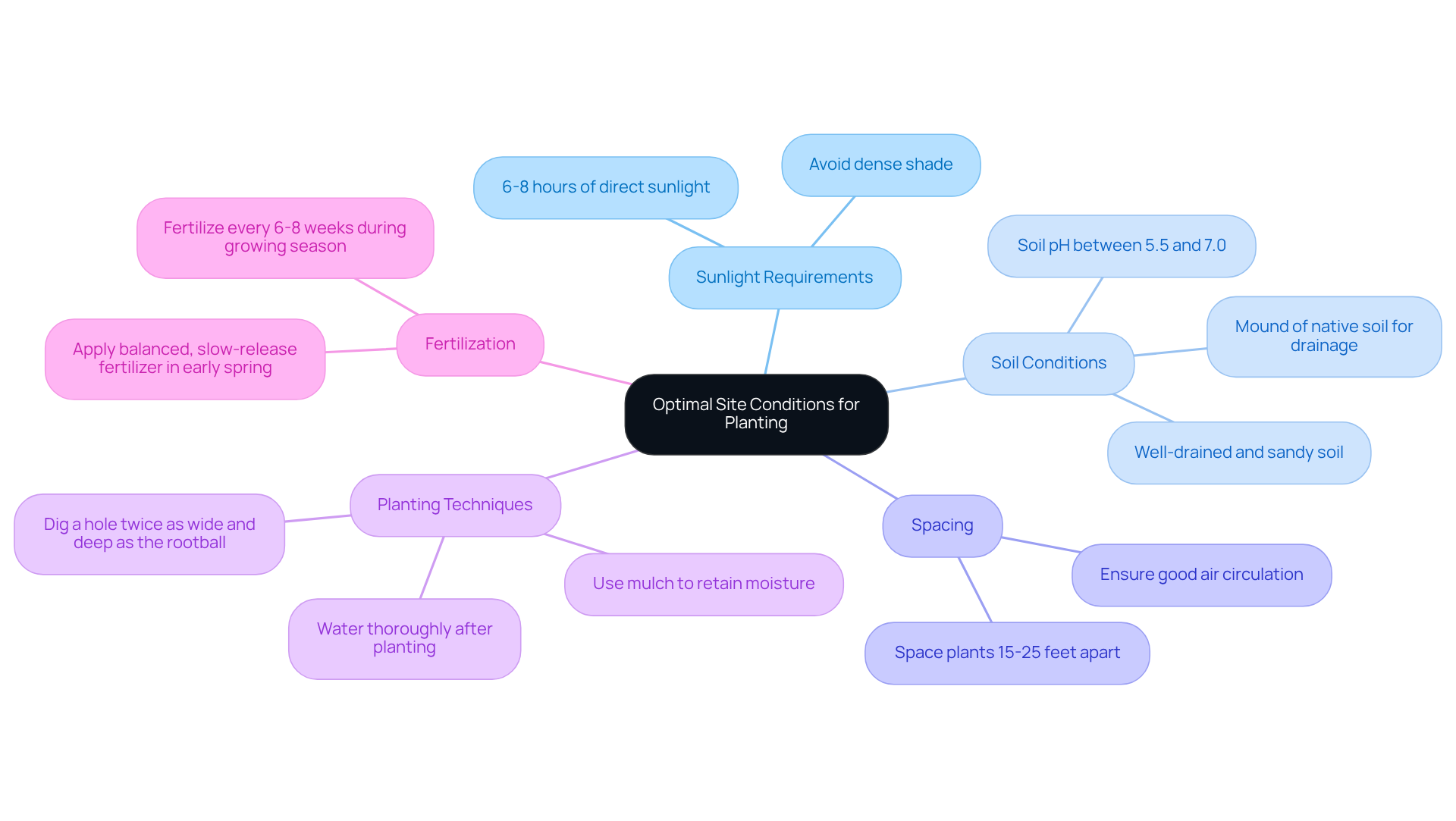
Essential Practices for Growing Your Fairchild #2 Canistel Tree
Share
Selecting the right conditions for planting a Fairchild #2 canistel tree is crucial for transforming it into a thriving, fruit-bearing plant rather than one that struggles to survive. This article explores essential practices that maximize growth potential and ensure sustainable cultivation. Given the various challenges, including pests, diseases, and environmental stressors, how can gardeners effectively nurture this tropical gem to achieve a bountiful harvest? Through careful attention to the planting conditions and ongoing care, gardeners can foster a healthy environment for their canistel trees.
🌱Want to grow a Canistel Tree in your garden?
Explore Fairchild #2 Canistel Trees for sale at Everglades Farm - shipped directly from Florida.
1. Select Optimal Site Conditions for Planting
To guarantee the successful development of your fairchild #2 canistel tree, it is essential to choose a planting location that receives each day. This exposure is crucial for optimal photosynthesis and crop production, as most plants require at least 6 to 8 hours of direct sunlight daily.
Additionally, the soil must be well-drained and sandy, as the fairchild #2 canistel tree is susceptible to root rot in waterlogged conditions. Consider planting on a mound of native soil, approximately 2-3 feet high and 4-10 feet in diameter, to enhance drainage and improve plant survival rates. This method mimics natural conditions and promotes healthy root development.
Avoid areas with dense shade or competition from other plants, as these factors can impede growth and fruit production. It is also important to space plants 15-25 feet apart to allow for adequate growth and air circulation. Regularly evaluate the area for any changes in sunlight or drainage that may impact the health of the plant.
As horticulturist Dave McNeely states, "Sunlight is essential for good fruit production," reinforcing the significance of site selection in nurturing a flourishing tropical fruit plant. Furthermore, using a balanced, slow-release fertilizer in early spring will encourage healthy development and fruiting.
For those interested in planting soursop alongside other fruits, similar best practices apply: ensure ample sunlight, well-drained soil, and proper spacing to foster a fruitful tropical garden.

2. Implement Care Techniques for Healthy Growth
To ensure the healthy development of your Canistel plant, establishing a consistent watering routine is essential, particularly in the early years. Water deeply every 2-3 weeks, allowing the soil to dry slightly between waterings to avoid over-saturation. Once established, the plant exhibits drought resistance but may require additional watering during prolonged dry spells.
Fertilization should occur every 6-8 weeks with a balanced fertilizer, especially during the growing season, to promote vigorous growth and enhance crop production. Agronomists recommend focusing on nutrient-dense fertilizers that benefit tropical crops, as these can significantly influence yield and plant health.
Regular pruning is equally vital; remove any dead or diseased branches and thin out crowded areas to improve air circulation and sunlight penetration. This practice not only enhances the plant's structure but also fosters better fruiting. Aim to trim in late winter or early spring before new growth begins, as this timing optimizes the plant's response to pruning and encourages vigorous yield development.
By adhering to these fertilization and care methods, you can cultivate a thriving plant that produces delightful fruit.
3. Manage Challenges for Sustainable Cultivation
To cultivate your Fairchild #2 canistel tree sustainably, is crucial. Pests such as aphids, scale insects, and mealybugs can threaten your plant's health. Consistently check your plant and address any infestations promptly, utilizing organic techniques like insecticidal soap or neem oil. Additionally, be vigilant for signs of diseases, including black mold or leaf spot. These issues can often be mitigated through proper air circulation and sanitation practices. Clearing away fallen leaves and debris is essential to prevent the spread of disease.
Soil health plays a vital role in the overall well-being of the Fairchild #2 canistel tree. Consider mulching around the base of the plant to retain moisture, suppress weeds, and enhance soil quality over time. This practice not only supports the plant's growth but also contributes to a healthier ecosystem. Lastly, be mindful of environmental factors such as extreme temperatures and humidity, which can stress your plant. Providing shade during excessively hot periods helps maintain a stable microclimate, ensuring your Fairchild #2 canistel tree thrives.
Conclusion
Selecting the right conditions and implementing effective care techniques are fundamental to the successful growth of the Fairchild #2 canistel tree. By understanding the specific requirements for sunlight, soil, and spacing, as well as maintaining a consistent watering and fertilization routine, growers can foster an environment where this tropical fruit tree can thrive.
Key practices include:
- Choosing a well-drained site with ample sunlight
- Adhering to a structured watering schedule
- Conducting regular pruning to enhance air circulation and fruit production
- Managing pests and diseases through vigilant monitoring and organic treatments
- Mulching and considering environmental factors to further contribute to sustainable cultivation
Ultimately, the journey of growing a Fairchild #2 canistel tree is not just about following best practices but also about fostering a deeper connection with nature and enjoying the rewards of your labor. Embrace these essential techniques and watch as your efforts yield a bountiful harvest, enriching both your garden and your palate.
Cultivate Your Tropical Paradise Today!
Start your journey with Everglades Farm and watch your Fairchild #2 canistel tree flourish.
Frequently Asked Questions
What are the ideal sunlight conditions for planting a fairchild #2 canistel tree?
The fairchild #2 canistel tree requires full sunlight for a minimum of 6-8 hours each day for optimal photosynthesis and crop production.
What type of soil is best for planting a fairchild #2 canistel tree?
The soil should be well-drained and sandy, as the fairchild #2 canistel tree is susceptible to root rot in waterlogged conditions.
How can I improve drainage when planting a fairchild #2 canistel tree?
Consider planting the tree on a mound of native soil that is approximately 2-3 feet high and 4-10 feet in diameter to enhance drainage and improve plant survival rates.
What spacing should be maintained between fairchild #2 canistel trees?
Plants should be spaced 15-25 feet apart to allow for adequate growth and air circulation.
What should I avoid when selecting a planting site for a fairchild #2 canistel tree?
Avoid areas with dense shade or competition from other plants, as these factors can impede growth and fruit production.
How can I promote healthy development and fruiting of the fairchild #2 canistel tree?
Use a balanced, slow-release fertilizer in early spring to encourage healthy development and fruiting.
Are the planting conditions for soursop similar to those for the fairchild #2 canistel tree?
Yes, similar best practices apply for planting soursop, including ensuring ample sunlight, well-drained soil, and proper spacing.


